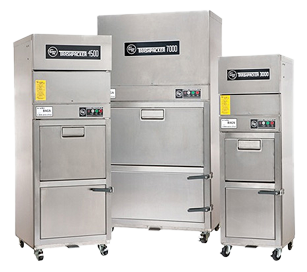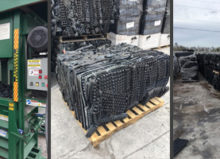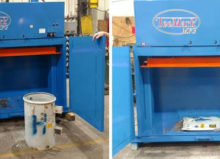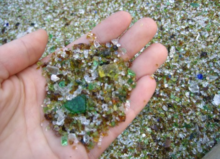What is an Indoor Vertical Trash Compactor?
 A Vertical Trash Compactor is a commercial volume reduction, recycling and waste management compactor and baler. The Chicago TrashPacker achieves a high compaction ratio which will save your business time and money. Keeping trash compacted and contained reduces hauling cost, eliminates mess, odor and pests.
A Vertical Trash Compactor is a commercial volume reduction, recycling and waste management compactor and baler. The Chicago TrashPacker achieves a high compaction ratio which will save your business time and money. Keeping trash compacted and contained reduces hauling cost, eliminates mess, odor and pests.
The Chicago TrashPacker will compact refuse such as food waste, mixed waste, cardboard, plastic film, kitchen, janitorial and room waste.
The Compactors Inc. Chicago TrashPacker has 3 models:
- Chicago TrashPacker Model TA3000SS
Capacity: 3.3 cubic feet (95 liters) – Ratios 20:1, Dimensions: 22 1/4″ wide x 22 1/4″ deep x 71 1/4″ tall - Chicago TrashPacker Model TA4500SS
Capacity: 6 cubic feet (170 liters) – Ratios 20:1, Dimensions: 28 1/4″ wide x 28″ deep x 77 3/4″ tall - Chicago TrashPacker Model TA7000SS
Capacity: 9 cubic feet (255 liters) – Ratios 20:1, Dimensions: 40 1/4″ wide x 28″ deep x 80 1/4″ tall
Each Model of our Chicago TrashPacker Stainless Steel Series (TA300SS, TA450SS, & TA700SS) is ABS Certified for Shipboard, Off-Shore and Marine / Maritime use. We have many Chicago TrashPackers installed on US Navy Vessels, US Coast Guard Vessels, Ocean Going Vessel and Cruise Ships worldwide.
Frequently asked Questions
What Industries would benefit from a Commercial Indoor Vertical Trash Compactor?
Hospitals, Surgical Centers, Nursing Homes, VA Medical Centers, Restaurants, Cafeterias, Commercial Kitchens, Hotels, Motels, Hospitality Firms, Schools, Universities, Day Care Facilities, Theme Parks, Apartment Bldgs., Housing Complexes, Office Buildings, Quick Serve Companies, Manufacturers, Ocean Going Vessels, Cruise Lines, Passenger Ships, Yachts, Offshore Industry, the Military, Marine and Off-Shore locations
How much do they cost?
- Chicago Trashpacker Indoor Vertical Compactor Model TA3000SS – $7,995.00
- Chicago Trashpacker Indoor Vertical Compactor Model TA4500SS – $8,995.00
- Chicago Trashpacker Indoor Vertical Compactor Model TA7000SS – $9,995.00
What material can you compact?
The Chicago TrashPackers are typically utilized on non-recyclable materials such as mixed waste that is being hauled to the landfill (versus recyclables that are being baled for transport to recycling centers). The Trashpacker will compact refuse such as food waste mixed with paper, cardboard, aluminum cans, bottles with caps off and general waste found in food service operations, schools, hospitals, residential and office buildings.
Baling Capabilities: Cardboard, Packaging Materials, Poly Bags, Lined Bulk Bags, Kraft Bags, Off-Cut film or film trim.
Non compactable items such as lumber, cement products, pipe, etc. should not be placed in the Compactor as these items may cause structural damage.
What size bale can you produce?
- Chicago TrashPacker Model TA3000SS – Capacity: 3.3 cubic feet (95 liters) – Compaction Ratios up to 20:1
- Chicago TrashPacker Model TA4500SS – Capacity: 6 cubic feet (170 liters) – Compaction Ratios up to 20:1
- Chicago TrashPacker Model TA7000SS – Capacity: 9 cubic feet (255 liters) – Compaction Ratios up to 20:1
How much of a footprint does a Chicago TrashPacker need?
- Chicago TrashPacker Model TA3000SS Dimensions: 22 1/4″ wide x 22 1/4″ deep x 71 1/4″ tall
- Chicago TrashPacker Model TA4500SS Dimensions: 28 1/4″ wide x 28″ deep x 77 3/4″ tall
- Chicago TrashPacker Model TA7000SS Dimensions: 40 1/4″ wide x 28″ deep x 80 1/4″ tall
How much does a Vertical Compactor Trashpacker weigh?
- Chicago TrashPacker Model TA3000SS: Service Weight 700 lbs.
- Chicago TrashPacker Model TA4500SS: Service Weight 900 lbs.
- Chicago TrashPacker Model TA7000SS: Service Weight 1200 lbs.
How does a Chicago TrashPacker ship?
Wrapped upright with stabilizing legs bolted to the compactor and a custom skid
How do you unload the Chicago TrashPacker from the truck?
A fork-lift or hand truck are the most used machines for unloading a Vertical Compactor/Trashpacker from a shipping truck. The lifting equipment must be designed for lifting the weight of the baler.
Installation and Commissioning considerations for the Chicago TrashPacker
1.Unwrap the unit.
2.Unbolt stabilizing legs from custom skid
3.Remove the Compactor from skid
4.Find the proper location to place the Compactor. This location should have a firm, level floor and adequate electrical power supply within reach of the power cord. A floor drain may be required for wet waste conditions. The electrical supply must be as follows: 115 volts single phase 20 amps, 60 cycle or 230 volts single phase 20-amp, 60 cycle. Refer to the unit nameplate for correct voltage.
ONLY A CERTIFIED ELECTRICIAN MUST HOOK UP THE COMPACTOR TO THE ADEQUATE POWER SUPPLY.
5.Move machine to the final location
6.Lock the caster brakes to prevent movement. If you have purchased a marine version, secure the deck legs to the deck.
7.Locate the keys from the power cord located in the back of the machine. Open the unloading door, remove the trash cube, accessories and instruction packet.
8.Check to see that all pieces of the shipment have arrived and are intact.
- Keys attached to power cord in rear of machine
- Breather Cap
- User manual
- Roll of bags
- Ejector strap
- Trash cube (2 piece)
Notice: Read Caution Page attached under acorn nut
9.Unscrew the acorn nut and remove the service panel.
10.Locate bag containing the breather cap
11.Locate the power unit and the hydraulic reservoir. Remove the plug/nut and replace it with the Breather Cap (When checking for proper Hydraulic fluid level, the compaction plate must always be in the UP position).
12.Remove the Bag Dispenser panel
13.Install the roll of trash bags on the Bag dispenser rod and replace the Bag Dispenser panel
14.Open the Unloading Door, place the ejector strap on the tab located on the upper back panel of the compaction chamber. Arrange the strap so that it falls to the bottom of the compaction chamber and out the front door
15.Remove a trash bag from the Bag Dispenser and place in the trash cube
16.Place the trash cube in the compaction chamber and close the Unloading Door (Locate the word “FRONT” on trash cube. This side should always be facing towards the front of Compactor)
The unit is now ready for operational testing. Refer to this manual and proceed with operator training and safety procedure.
What Trash Compactor Bags and Plastic Strapping are used with the Chicago TrashPacker?
- Chicago TrashPacker Model TA3000SS Trash Compactor Bags item number – TP00911 or MP-30
- Chicago TrashPacker Model TA4500SS Trash Compactor Bags item number – TP00223, MP-60 or MP-60HD
- Chicago TrashPacker Model TA7000SS Trash Compactor Bags item number – TP00224, MP-70
For all models of the Chicago TrashPacker – Strapping Kit Plastic or Bailing Twine
How to build a mixed waste bagged trash slug, or a bale of recycled material with the Chicago TrashPacker
General Operating Procedures
- Follow all applicable safety requirements.
- Open the Unloading Door and remove the trash cube from the compaction chamber.
- Remove a trash bag from the bag dispenser and place in the trash cube. Make sure there is a little extra in the bottom of the cube. Fold the top of the bag over the edge of the trash cube and turn the excess bag upward forming a cuff on all four sides.
- Locate the word “FRONT” on trash cube. This side should always be facing towards the front of Compactor, then return the cube to the compaction chamber. Close and latch the Unloading Door.
- Insert the key and turn to the ON position.
- Insert the trash through the Loading Door. Close the Loading Door and start the machine by pushing the Green Start Push Button. The machine will complete one compaction cycle and automatically shut off. The Compactor does not have to be cycled every time that trash is placed in the unit only when the trash reaches a few inches below the compaction plate. Pushing the RED STOP PUSH BUTTON will shut down the Compactor at any time!
- The RED Full Indicator light and warning buzzer will activate when the Compactor needs to be unloaded.
- The Odor Control System is operational only when the key switch is turned on. Leaving the key on during “off business hours” will ensure that odors are kept under control. No maintenance is required for Odor Control System.
Manual Unloading
After the Compactor is full it can be unloaded in the following manner:
- Silence the buzzer by pressing the Red Stop Push Button, the Red Full Indicator light will remain on and the compaction plate will stay down.
- Turn the key to the OFF position and then back to the ON position. Press the Green Start Push Button. The compaction plate will retract to its fully UP position. Turn the key to the OFF position.
- Open the Unloading Door exposing the trash cube.
- Pull the trash cube out of the compactor, tie off the bag and remove bag from trash cube and dispose of bag.
- Install new bag in trash cube and place back into compaction chamber. Close and secure the Unloading Door. Your compactor is ready for another compaction cycle.
- If using the optional Trashlift, open the Unloading Door and position the Trashlift in front of the trash cube. Lock the castors on the Trashlift and pull the trash cube out of Compactor and onto the Trashlift platform. Take the sides of the trash bag and pull up and over. Tie the bag closed. Transport the trash cube on the Trashlift to the dumpster. Remove the top portion of the trash cube exposing the bag. The Trashlift should be raised to the desired height, brace the trash cube tray, and push the bag into the trash receptacle. Lower the Trashlift platform, reassemble the trash cube, install a new bag, and put the trash cube back into the compaction chamber.
Baler Operations for Recycling Materials
- Operator must be completely familiar with the Trashpacker and how it works prior to proceeding.
- Cut two 10 ft lengths of strapping and thread them through the tabs in the rear of the compaction chamber and the lower front tabs. There must be excess lengths of straps on both ends.
- Place a piece of cardboard (18″ sq.) flat in the bottom of the chamber over the strapping to hold the straps in place.
- Close the service door and being filling the Trashpacker with boxes.
- When a full condition is indicated, turn the key off then on and press the green start button. Plate will retract to its full up position. Turn the key off.
- Open the service door and remove the straps from the rear inside tabs and from the lower front tabs of the chamber.
- Obtain two tension clips and thread the ends of the straps through the clips. Position each clip toward the front top of the bale, not under the compaction plate.
- CAUTION: KEEP CLEAR OF THE COMPACTION PLATE DURING THE FOLLOWING OPERATIONS!
- Turn key switch to the left momentary on position and at the same time, press the start button to allow compaction plate to go down and re-compress the bale. Turn unit off by releasing the key switch to the off position. This sequence allows for a tight bale. Now pull up the excess strap and tie off the bale.
- Finished bale can now be removed and disposed. m the lower front tabs of the chamber
Electrical Options:
- Chicago Trashpacker Vertical Compactor Model TA3000SS, 120 Volts, Single Phase, 60 Hz.
- Chicago Trashpacker Vertical Compactor Model TA4500SS, 120 Volts, Single Phase, 60 Hz.
- Chicago Trashpacker Vertical Compactor Model TA7000SS, 220 Volts, Single Phase, 60 Hz. Please note this machine does not come with a plug and must be hardwired.
** We can also supply electrical options for 50Hz. Motors.
Hydraulic oil
Lubrication and transmission of power, we recommend use of a quality grade high pressure anti wear hydraulic oil, petroleum based, non-synthetic, I.S.O. Grade 32 AW fluid.
Oil capacities (approximate)
- Model TA3000SS – 5 quarts
- Model TA4500SS – 6 quarts
- Model TA7000SS – 10 quarts
Safety system included
All stainless-steel exterior
All stainless-steel compaction chamber
Heavy duty welded construction
Push button controls
Multi-operational key switch
UL Listed Components
UV Germicidal unit for odor control & to eliminate bacteria, viruses & harmful contaminants
Reusable split trashcube
Safety interlock system
Heavy duty compaction plate
Modular electrical system
Two stage hydraulic pump
Trashcube ejector system
Bag dispenser
Full indicator, buzzer & light
Preventative Maintenance
General Maintenance
Clean your Compactor Often
*DISCONNECT ELECTRICAL POWER BEFORE SERVICING TO AVOID ELECTRICAL SHOCK HAZARD!
Frequent cleaning will not only minimize odors but will increase the life of the Compactor.
DAILY: Once each day clean outside and inside of Compactor. Wipe down the compaction chamber with warm soapy water. Take care not to allow the door safety switch or other electrical components to get wet, or an electrical short may occur.
To clean the top of the compaction plate, run the plate halfway down then shut off unit.
UNPLUG the Compactor and open service door and clean compaction plate.
WEEKLY: Grease guide rods and check hydraulic fluid level with the compaction plate all the way up. Use the high quality with lithium grease. Run compaction plate halfway down to grease the guide rods.
MONTHLY: Check for hydraulic fluid leaks, loose hose and wire connections and loose mounting hardware. Check door latches and hinges. Lubricate door hinges, handles and loading door latch. Check electrical buttons, Green Push Button, Red Stop Button, and Key Switch.
ANNUALLY: Change hydraulic fluid, if needed.
To Check and Fill:
Most pump and valve malfunctions can be traced to hydraulic system contamination.
Always use clean hydraulic fluid and clean funnel with a fine wire mesh filter.
Keep reservoir about ¾ full. Always use care to keep hydraulic fluid clean.
Compaction plate must be all the way up prior to filling.
Cycle Compactor.
Add hydraulic fluid to about 1” below filler hole.
Cycle Compactor several times. Recheck fluid level and repeat if necessary.
Recommend hydraulic fluid: To properly perform the dual function of lubrication and transmission of power, we recommend use of a quality grade high pressure anti wear hydraulic oil, petroleum based, non-synthetic, I.S.O.
Grade 32 AW fluid. Operation at fluid temperatures below 130 F is recommended to obtain maximum unit and fluid life.
Troubleshooting:
- Is the machine plugged in and the key in the ON position?
- Is the fuse or circuit breaker working?
- Are both the loading door and service door closed?
- Are wire connections tight and secure?
If a problem develops, call Compactors Inc. for assistance at 800-423-4003 or 843-686-5503.
Options available
- Heavy duty deck legs for marine or shipboard installation
- Trash Compactor Bags, Standard or Heavy-Duty Mill thickness
- Split trashcube
- Strapping Kit Plastic, or Baling Cord / Twine
- TL4500 Trashlift for TA3000SS & TA4500SS
- TL7000 Trashlift for TA7000SS



